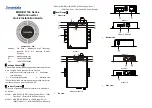
Country-
spec. Set-
tings
Men
u
level
Display/
Setting
Action in this menu/meaning
Increasing output gra-
dient & Decreasing
output gradient
1 - 65534 [% / min]
Specifies the dynamic behaviour at change of active power change for
power increase. On a voltage change, the active power is changed with
the specified gradient.
The gradient is superimposed with the settling time.
Specifies the dynamic behaviour at change of active power change for
power decrease. On a voltage change, the active power is changed with
the specified gradient.
The gradient is superimposed with the settling time.
Settling time
100 – 1200000 [ms]
Specifies the dynamic behaviour at change of active power set point. On
a voltage change, the active power is changed according a PT-1 charac-
teristic with a settling time equal to 5 Tau.
Note: The settling time is superimposed with the increase and decrease
gradient.
Number of nodes
2- 5
Power
0.0 -100.0 [%]
Voltage
0.0 -126.0 [%]
Up to 5 nodes configurable for voltage [V] and power [% Pref]. The
power-value of the first and the last value pair is also used as maximum,
minimum respectively active power value which is valid beyond the lim-
its of the characteristic.
4
1
2
3
4
Active curve
1 - 5
F
Select the active curve.
NOTE: Up to 5 characteristic curves can be configured independently
and one of them can be activated for regulation each time.
10.2.3
P(f)
P(f) Active power response to overfrequence
Feed-in inverters must assist with frequency stability in the grid. If the grid frequency leaves the normal tolerance range
(e.g. ±200 mHz), the grid is in a critical state. In the event of overfrequency, there is a generation surplus, in the event of
underfrequency, there is a generation deficit.
PV-Systems must adapt their active feed-in power in relation to the frequency deviation. In case of overfrequency the
adaption of power is defined by a maximum feed-in limit. The actual power of the inverter may vary freely below this
limit based on possible fluctuation of the available power or set point, but will never increase above the absolute power
limit.
Fig. 90:
Equation 1
Fig. 91:
Equation 2
Equation 1 [See figure 90] [
Page 81] defines the maximum limit with ΔP according to Equation 2 [See figure 91]
M
the actual power at the moment of activation and P
ref
the reference power. In KACO PV inverters P
ref
is
defined as P
M
, the actual power at the moment of activation. f is the actual frequency and f
1
is the activation threshold as
configured.
Fig. 92:
Equation 3
KACO blueplanet 87.0 TL3 KACO blueplanet 92.0 TL3 KACO blueplanet 110 TL3 KACO blueplanet 125 TL3
KACO blueplanet 137 TL3 KACO blueplanet 150 TL3
Page 81
EN-US
















































